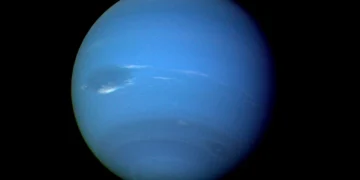Uranus and Neptune, often overshadowed by their flashier planetary neighbors, have intrigued scientists with their striking blue-green hues and mysterious magnetic fields. Now, a groundbreaking theory has added water — and lots of it — to the list of enigmas surrounding these distant worlds.
The Overlooked Giants of the Solar System
Uranus and Neptune, the seventh and eighth planets from the Sun, are the solar system’s enigmatic ice giants. While their distinctive colors and serene appearances might suggest simplicity, these planets conceal complex internal structures and unique behaviors. Voyager 2, NASA’s only mission to visit them, provided a fleeting glimpse during flybys in the late 1980s, revealing unusual magnetic fields and methane-rich atmospheres.
Despite this, these planets have remained largely unexplored, leaving many unanswered questions. Recent research published in the Proceedings of the National Academy of Sciences has reignited interest in these giants. Utilizing advanced computer simulations, scientists propose that Uranus and Neptune contain layered interiors with distinct compositions, including vast oceans beneath their atmospheres.
The Science Behind the Discovery
At the heart of this new theory is the idea that the interiors of Uranus and Neptune consist of distinct layers that don’t mix, akin to oil and water. The uppermost layer is a thick atmosphere dominated by hydrogen and helium. Beneath this lies an enormous ocean made of water, ammonia, and other volatiles. Further below is a dense layer of hydrocarbons, a compressed fluid composed of carbon, nitrogen, and hydrogen. These layers, spanning approximately 5,000 miles, are maintained by the extreme pressures and temperatures within the planets.
This stratification results from the unique chemical and physical processes in the planets’ interiors. The immense pressure breaks down methane, releasing hydrogen and separating it from heavier elements. This process creates a stable boundary between the ocean and hydrocarbon layer, ensuring little mixing between the two.
Why This Is So Important
1. Understanding Magnetic Fields
One of the most puzzling features of Uranus and Neptune is their erratic and misaligned magnetic fields. Unlike Earth’s dipolar magnetic field, generated by its rotating iron core, these planets exhibit fields that are tilted and chaotic. Scientists believe this is due to the lack of mixing in their deep interiors. The new model supports this hypothesis by showing how the stratified layers disrupt the dynamo effect that typically generates planetary magnetic fields.
2. Expanding the Search for Life
Water is a cornerstone of life as we know it, and its potential abundance on Uranus and Neptune adds these planets to the growing list of celestial bodies where life might exist. While the extreme conditions on these ice giants make it unlikely for life to thrive as it does on Earth, the discovery underscores the diversity of planetary environments.
3. Advancing Planetary Science
The layered structures of Uranus and Neptune challenge conventional models of planetary formation and evolution. By studying these planets, scientists can refine their understanding of how planets form under varying conditions.
The Role of Voyager 2 and Future Missions
NASA’s Voyager 2 spacecraft remains the sole mission to visit Uranus and Neptune, providing invaluable data during its flybys in 1986 and 1989. However, these brief encounters only scratched the surface of what these planets have to offer. The new findings highlight the need for dedicated missions to these ice giants. Proposed projects, such as the Uranus Orbiter and Probe, could revolutionize our understanding by directly sampling the atmosphere, studying magnetic fields, and probing the mysterious oceans. Future missions could also deploy advanced instruments to measure gravitational anomalies, map internal structures, and analyze atmospheric compositions. Such data would confirm or refute the existence of deep oceans and refine models of planetary dynamics.
Broader Implications for the Universe
The significance of Uranus and Neptune extends beyond our solar system. Ice giants are the most common type of planet detected in the Milky Way, often classified as “mini-Neptunes” or “sub-Neptunes” in exoplanet studies. Understanding the internal structures and behaviors of Uranus and Neptune provides a template for interpreting the data from distant worlds. If deep oceans are common among ice giants, it could reshape our understanding of planetary habitability and the distribution of water in the universe.
A Call to Action: Exploring the Ice Giants
The revelations about Uranus and Neptune’s potential oceans and layered interiors emphasize the urgency of further exploration. These planets hold the keys to understanding fundamental questions about planetary formation, magnetic fields, and the conditions necessary for life. With advancements in technology and renewed interest in space exploration, a dedicated mission to these enigmatic worlds seems not just possible but essential.
Investing in missions to Uranus and Neptune would not only unlock their secrets but also inspire a new generation of scientists and explorers. As humanity reaches further into the cosmos, understanding our solar system’s most distant planets will provide context and guidance for studying the broader universe.
Conclusion
The discovery of potential oceans beneath the atmospheres of Uranus and Neptune is a game-changer in planetary science. It challenges long-held assumptions, offers explanations for the planets’ peculiarities, and raises exciting possibilities for the search for life. As we stand on the brink of a new era in space exploration, these ice giants remind us of the mysteries waiting to be uncovered in our celestial backyard. With dedicated missions and continued research, Uranus and Neptune could transform from overlooked outliers to key pieces in the puzzle of our solar system and beyond.
Reference:
Phase separation of planetary ices explains nondipolar magnetic fields of Uranus and Neptune



















